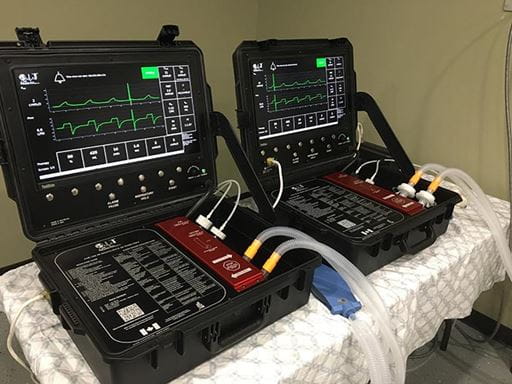Released on December 3, 2020
One hundred made-in-Saskatchewan ventilators will soon be available to support the needs of the province’s residents.
This is the result of an innovative Saskatchewan collaboration between the University of Saskatchewan (USask), the Saskatchewan Health Authority (SHA), and RMD Engineering Inc. These organizations applied subject matter expertise, research and entrepreneurship to pave the way for Saskatchewan to return to medical device manufacturing.
RMD Engineering Inc. is a Saskatoon-based company whose subsidiary, One Health Medical Technologies, recently received COVID-19 Medical Device Authorization from Health Canada for an in-house designed, developed and manufactured ventilator. Collaborating with the USask and SHA subject matter experts, RMD Engineering was able to successfully prototype an emergency use ventilator (EUV-SK1) for Health Canada certification.
“This initiative exemplifies the spirit of collaboration and entrepreneurship we’re so proud of in our province,” Health Minister Paul Merriman said. “Our government fully supports this work, and we are pleased that residents in Saskatchewan and across the country will have access to this equipment, if they need it.”

“When COVID hit, my daughter, a Royal University Hospital ICU nurse, raised awareness of the potential impact on the healthcare system” RMD Engineering Group of Companies President Jim Boire said. “Knowing we had the skillset, capability, and capacity in-house, we chose to do something rather than nothing and created an emergency use ventilator using reliable technology and readily available materials. When we communicated our intent, we received a high level of trust from the Saskatchewan Health Authority and the leadership of the University of Saskatchewan Colleges of Engineering and Medicine, which led to a world-class collaboration.”
“We are delighted to have played a key role in supporting RMD’s development of this innovative technology that will help save lives and create jobs in Saskatchewan,” USask Vice-President Research Karen Chad said. “This success is the result of a visionary company, a health authority, and a top research university with expertise in many fields working together to help meet the critical needs of the province and the world.”
This approval now paves the way for One Health Medical Technologies to sell their ventilator to the Saskatchewan Health Authority, and subsequently to the Canadian healthcare market. The Saskatchewan Government has given the SHA approval to purchase 100 EUV-SK1 ventilators for patients who need them across the province, adding to the ventilators already earmarked for its COVID-19 response.
There are currently approximately 650 ventilators available in Saskatchewan’s health system, enough to meet the need. They range from high-end critical care type ventilators to more basic sub-acute ventilators. The SHA’s purchase from RMD will increase that number to about 750.
“The SHA is grateful for the dedication and work that RMD Engineering has invested in creating a Saskatchewan-made solution to support the needs of patients for ventilator support as the COVID-19 pandemic continues,” SHA Executive Director Provincial Programs – Tertiary Care Lori Garchinski said. “Enhancing our ventilator capacity allows for frontline teams to balance the needs of their patients with the appropriate available equipment.”
Contract details are still being finalized, with RMD’s One Health Medical Technologies expected to have the first 20 ventilators ready for delivery by December 7, 2020.
-30-
For more information, contact:
Jennifer Graham
Health
Regina
Phone: 306-787-4083
Email: Media@health.gov.sk.ca
Cell: 306-537-3594
Victoria Dinh
USask Media Relations
Saskatoon
Phone: 306-966-5487
Email: Victoria.dinh@usask.ca
RMD Engineering Inc.
Saskatoon
Phone: 306-934-8753
Email: communications@rmd-engineering.com
One Health Medical Technologies
Saskatoon
Phone: 306-934-8760
Email: communications@onehealthmedtech.com
Media Relations
Saskatchewan Health Authority
Phone: 1-833-766-4392
Email: media@saskhealthauthority.ca

